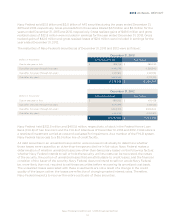Navy Federal Credit Union 2013 Annual Report Download - page 28
Download and view the complete annual report
Please find page 28 of the 2013 Navy Federal Credit Union annual report below. You can navigate through the pages in the report by either clicking on the pages listed below, or by using the keyword search tool below to find specific information within the annual report.Navy Federal Credit Union • 2013 Financial Section
8
2013 ANNUAL REPORT
Loan origination fees and certain direct origination costs are deferred and amortized over the life of the
loans using the interest method under ASC 310-20, Receivables—Non-refundable Fees and Other Costs.
Allowance for Loan Losses
Navy Federal accrues estimated losses in accordance with ASC 450, Contingencies. The allowance
for loan losses is a reserve, or contra asset, against Loans to members established through a provision
for loan losses charged to expense. Loan principal is charged against the allowance for loan losses
when management believes that the collectability of the amount is unlikely; subsequent recoveries are
credited to the allowance for loan losses. Navy Federal’s loan portfolio consists mainly of large groups
of smaller-balance homogeneous loans that are collectively evaluated for impairment. The allowance
for loan losses is maintained at a level that, in management’s judgment, is sucient to absorb losses
inherent in the portfolio based on evaluations of the collectability of loans and prior loan loss experience.
The evaluations take into consideration such factors as changes in the value of loans outstanding, prior
history of charge-os and recoveries, overall delinquency and delinquencies by loan product, and current
economic conditions and trends that may aect a borrower’s ability to pay. The allowance for loan losses
is reviewed on a monthly basis, and the provision that is charged to expense is adjusted accordingly.
Acquired Credit-Impaired Loans
ASC 310-30, Loans and Debt Securities Acquired with Deteriorated Credit Quality, addresses
accounting for dierences, attributable to credit quality, between contractual cash flows and cash
flows expected to be collected from an investor’s initial investment in loans or debt securities acquired
in a transfer. Acquired loans are considered to be impaired if Navy Federal does not expect to receive
all contractually required cash flows and the loans have exhibited credit deterioration since origination.
Credit deterioration can be evidenced by lower FICO scores or past-due status. Acquired credit-
impaired (ACI) loans are recorded at fair value at acquisition, determined by discounting expected
future principal and interest cash flows. The excess of the expected future cash flows on ACI loans
over the recorded investment is referred to as accretable yield, which is recognized as interest income
over the remaining life of the loan using an eective yield methodology. The dierence between
contractually required payments at acquisition date, considering the impact of prepayments and
credit losses expected over the life of the loan, and the cash flows expected to be collected is referred
to as the non-accretable dierence.
Each quarter, Navy Federal re-evaluates the performance and credit quality of its ACI loans by
aggregating individual loans that have common risk characteristics and estimating their expected future
cash flows. Decreases in expected or actual cash flows that are attributable, at least in part, to credit
quality are charged to the provision for loan losses resulting in an increase in the allowance for loan
losses. Conversely, increases in expected or actual cash flows are treated as a recovery of any previously
recorded allowance for loan losses, and to the extent applicable, are reclassified from non-accretable
dierence to accretable yield. Increases in expected prepayments not attributable to credit quality are
treated as a reduction in contractual cash flows expected to be collected and a reduction of projections
of contractual cash flows, such that the non-accretable dierence is not aected, but instead the
eective interest yield is reduced prospectively.
Navy Federal’s ACI loans are accounted for in pools. Loans deemed uncollectible on an individual basis
remain in the pool and are not reported as charge-os. Disposals of loans, whether through sale or
foreclosure, result in the loan’s removal from the pool at its carrying amount. See Note 6 for details.
Troubled Debt Restructurings
A troubled debt restructuring (TDR) is a loan for which Navy Federal has granted a concession that
it would not otherwise consider because that member is experiencing financial diculty. The types
of concessions that Navy Federal grants in a TDR primarily include term extensions and interest rate
























